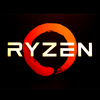2nd Generation AM5 Platform with X870E and X870 Chipsets
AMD has announced the launch of its 2nd Generation AM5 platform, introducing the new 800-series chipsets, beginning with the high-end X870E and X870 motherboards. This release will be followed by more mainstream options. The AMD AM4 platform, initially introduced in 2017, continues to be relevant in 2024, with recent chip releases extending its viability until 2025. However, AMD is now shifting focus to its new AM5 platform, specifically the 800-series family aimed at enthusiasts.
The X870E and X870 chipsets are designed to deliver enhanced features, improved I/O memory support, and additional overclocking capabilities for current and future Ryzen CPUs, including the Zen 5-based Ryzen 9000 "Granite Ridge" family. Several significant upgrades have been made in the AMD X870E and X870 motherboards:
- USB 4.0 Standard: All X870 and X870E motherboards come equipped with USB 4.0 support.
- PCIe Gen5: These motherboards support PCIe Gen5 for both graphics and NVMe storage.
- Higher EXPO Memory Clock Support: Enhanced memory clock speeds are supported on all X870 and X870E motherboards.
AMD has also disclosed the introduction of new Precision Boost Overdrive (PBO) and Curve Optimizer (CO) algorithms with Ryzen 9000 CPUs, which will be fully supported by these new motherboards. In addition to the X870E and X870 motherboards, AMD plans to release the B850 and B840 chipsets targeting the mainstream market. The chipset lineup includes:
These motherboards will natively support DDR5-5600 MT/s memory speeds, with potential transfer rates exceeding 8000 MT/s on some high-end models, expected to be available by July.
AMD Ryzen 9000 Series Memory Overclocking and Curve Shaper Enhancements
This latest generation of AMD processors allows users to reach memory speeds as high as DDR5-8000 by implementing a 1:2 ratio between the memory controller speed and the memory speed itself. This represents an upgrade from the DDR5-5200 support in the Ryzen 7000 series to DDR5-5600, aligning with the memory speeds supported by Intel’s current processors. AMD has introduced a convenient tool for dynamic memory overclocking within Windows through its Ryzen Master software. This software includes a unique feature with a simple button that toggles between two pre-trained memory profiles. One profile adheres to the Jedec standard, ensuring stability for critical tasks, while the other, known as the EXPO profile, is tailored for optimal gaming performance.
In addition to memory tuning, AMD has rolled out Curve Shaper, a novel feature accessible via the BIOS on AM5 motherboards compatible with Ryzen 9000 CPUs. Building on the existing Curve Optimizer, Curve Shaper enhances the ability to fine-tune processor performance. It does this by allowing adjustments to the voltage-frequency curve, enabling users to set specific undervolt offsets for different combinations of clock speeds and temperatures. This capability is designed to reduce power consumption, which in turn gives AMD’s Precision Boost Overdrive (PBO) technology more flexibility to boost clock speeds and improve overall system performance.




